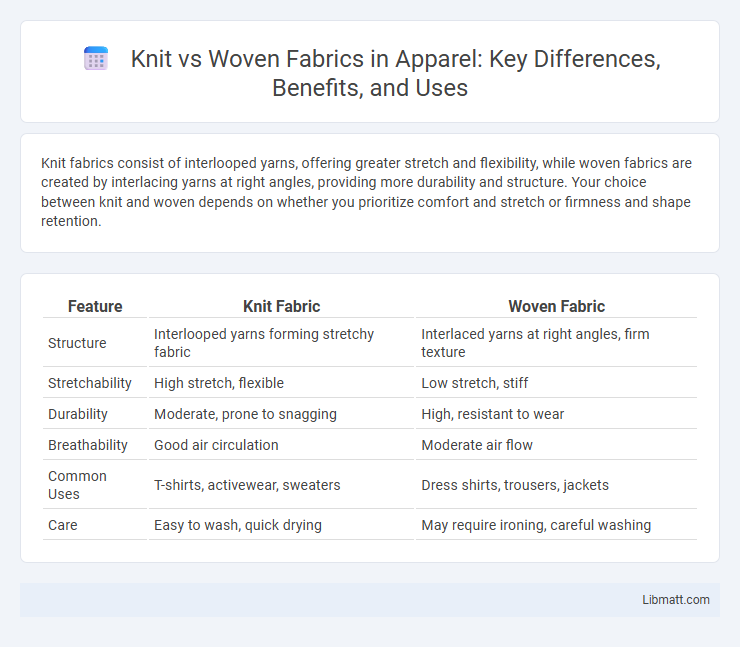Knit fabrics consist of interlooped yarns, offering greater stretch and flexibility, while woven fabrics are created by interlacing yarns at right angles, providing more durability and structure. Your choice between knit and woven depends on whether you prioritize comfort and stretch or firmness and shape retention.
Table of Comparison
| Feature | Knit Fabric | Woven Fabric |
|---|---|---|
| Structure | Interlooped yarns forming stretchy fabric | Interlaced yarns at right angles, firm texture |
| Stretchability | High stretch, flexible | Low stretch, stiff |
| Durability | Moderate, prone to snagging | High, resistant to wear |
| Breathability | Good air circulation | Moderate air flow |
| Common Uses | T-shirts, activewear, sweaters | Dress shirts, trousers, jackets |
| Care | Easy to wash, quick drying | May require ironing, careful washing |
Understanding Knit and Woven Fabrics
Knit fabrics are created by interlocking loops of yarn, offering superior stretch, breathability, and comfort, making them ideal for activewear and casual clothing. Woven fabrics consist of yarns woven at right angles, providing durability, structure, and resistance to stretching, commonly used in formal wear and upholstery. Understanding the differences helps you choose the right fabric based on the desired flexibility, texture, and end-use application.
Key Differences Between Knit and Woven
Knit fabrics are constructed by interlooping yarns, providing superior stretch and flexibility, making them ideal for activewear and casual clothing. Woven fabrics consist of interlaced yarns at right angles, offering durability and a structured form, commonly used in formal wear and upholstery. Your choice depends on the desired elasticity and texture, with knits excelling in comfort and wovens in strength and shape retention.
Fabric Construction: How Knits and Wovens are Made
Knit fabrics are created by interlooping yarns, resulting in a flexible and stretchy texture ideal for garments requiring comfort and movement. Woven fabrics are produced by interlacing two sets of yarns at right angles, providing a structured and durable material suitable for formal wear and upholstery. The construction methods directly influence their performance characteristics, with knits offering elasticity and wovens offering stability.
Durability and Strength Comparison
Knit fabrics offer superior stretch and flexibility but typically have lower durability and strength compared to woven fabrics, which are tightly interlaced for enhanced resilience and longevity. Woven textiles resist tearing and abrasion better, making them ideal for heavy-duty applications, while knits are more prone to snagging and pilling under stress. Your choice between knit and woven should consider the balance between comfort and strength needs based on the intended use of the garment or product.
Comfort and Flexibility: Knit vs Woven
Knit fabrics offer superior comfort and flexibility due to their looped construction, allowing for greater stretch and movement compared to woven fabrics, which are made from interlaced threads creating a firmer, less elastic surface. This elasticity in knit materials makes them ideal for activewear and garments requiring ease of motion, while woven fabrics provide structure and durability suited for tailored clothing. The breathability of knit fabrics also enhances comfort by promoting air circulation, whereas woven fabrics tend to retain more heat.
Breathability and Moisture-Wicking Properties
Knit fabrics offer superior breathability and moisture-wicking properties due to their looped construction, which allows air to circulate freely and quickly evaporate sweat. Woven fabrics, characterized by their tightly interlaced threads, tend to be less breathable and retain moisture longer, making them less effective for activewear or hot climates. Choosing knit materials enhances comfort by keeping your skin cool and dry during physical activities.
Common Uses: Knit and Woven Applications
Knit fabrics, known for their stretch and flexibility, are commonly used in activewear, casual clothing, and underwear where comfort and movement are essential. Woven fabrics, characterized by their stability and durability, are ideal for formal wear, dress shirts, and upholstery requiring structure and strength. Your choice between knit and woven depends on the desired garment function and performance requirements.
Maintenance and Care Tips
Knit fabrics require gentle handling during washing to prevent stretching and pilling, ideally using cold water and air drying to maintain their shape. Woven fabrics are more resistant to stretching but may need ironing to avoid wrinkles and should be washed according to fiber content to preserve durability. You can extend the life of both by following specific care instructions and avoiding harsh detergents or bleach.
Cost Comparison: Knit vs Woven Fabrics
Knit fabrics generally cost more to produce than woven fabrics due to the complex machinery and time-intensive processes involved. Woven fabrics benefit from faster production speeds and lower material waste, making them more economical for large-scale manufacturing. For budget-conscious projects, woven fabrics offer a cost-effective solution without compromising durability and quality.
Choosing the Right Fabric for Your Project
Knit fabrics offer excellent stretch and flexibility, making them ideal for activewear and garments requiring comfort and movement, while woven fabrics provide durability and structure, perfect for tailored clothing and upholstery. Understanding the specific requirements of your project, such as breathability, elasticity, and drape, will help you select the fabric that enhances both performance and aesthetics. Your choice between knit and woven fabric directly impacts the finished product's fit, feel, and longevity.
knit vs woven Infographic

 libmatt.com
libmatt.com